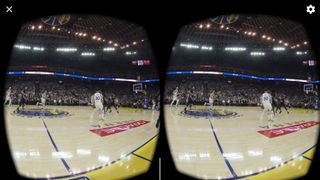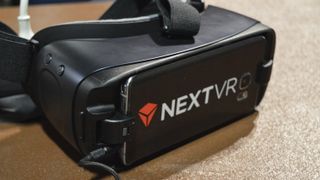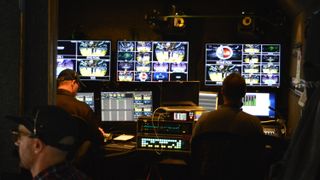Inside NextVR's big bet to take you inside the game and everywhere else
The NBA in virtual reality is just the beginning

The opening buzzer sounds, and within minutes I see Golden State Warriors superstar Stephen Curry running straight towards me, ball in hand. Suddenly, the ball leaves his hands and flies straight through the net, like magic.
I'm watching from a slightly perched position, almost as if I'm the tallest person in a room full of basketball players, or like I climbed the basketball pole and am peering around the backboard.
Of course, I didn't climb the pole at an NBA game for what could be the best (and most expensive) seat in the house. Instead, I'm sitting in a back room at Oracle Arena with a Samsung Gear VR headset on. To be sure, the view didn't fool me into thinking I was actually at the game, but it got scarily close.
There's been a lot of noise about virtual reality over the past few years, and that's unlikely to change. While we've heard VR will "totally change how we consume media" uttered by many an exec, the fact is the tech still has a long way to go. But, it's getting better, and when it comes to live sports, NextVR is leading the way.
Tech at the court
NextVR may talk up its deal with the NBA, which allows the company to stream one league game per week, but the business is just that – business. At the core of NextVR's mission to fast-track the future is technology. And, boy, is there a lot.
One of the most important aspects of how NextVR delivers VR video to its customers is the camera, and there are a few placed strategically around the arena.
At the core of NextVR's mission to fast-track the future is technology. And, boy, is there a lot
First are the three main cameras. One is placed on each net pole, and one sits on a table at half court. There are a few other cameras placed around the arena for use when the game isn't being played, and each camera has its own microphone. NextVR didn't want to talk about the exact specs of those cameras, but it will say that they're getting better, offering higher resolutions and clearer images than previous models.
Get daily insight, inspiration and deals in your inbox
Get the hottest deals available in your inbox plus news, reviews, opinion, analysis and more from the TechRadar team.
The company also told us that around the arena, there are 24,000 x 6,000 pixels of video, which is obviously far more than any VR playback device can handle right now. Because of that, the footage that's captured is somewhat "dumbed down" to make sense to today's headsets.

The footage is sent straight to an unassuming truck parked in a back lot, in this case at the Oracle Arena in Oakland, Calif. There, a suite of video producers, editors and engineer survey the footage while a director cuts between the different streams to ensure a smooth delivery for those watching.
"Our director really has it down to a science in how he cuts it to make sure the viewer is always looking in the right direction and things like that," said Josh Earl, coordinating producer at NextVR, in an interview with TechRadar.
All of the footage and work behind the scenes goes into a live-streamed feed sent straight to the NextVR app, which currently supports Google Daydream and the Samsung Gear VR, although we were told that another mystery platform will be supported in the near future.
You can watch replays and highlights through the app for free, but if you want to watch the games live you'll need to pay for an NBA League Pass, which currently sit at $49 as the regular season draws to a close.
The resolution of the footage needs to be much higher, and that's on both software and hardware manufacturers to accomplish.
The end product is not as perfect as the arc on a Curry three-point shot, however. The Google Daydream app, for example, was very buggy on the Google Pixel XL I tested it on. Not only that, but to feel like I'm really there, the resolution of the footage needs to be much higher, and that's on both software and hardware manufacturers to accomplish.
Those two things – app stability and content quality – are crucial to whether NextVR's concept can become more mainstream. There are other things NextVR is working hard on, but, again, the company wouldn't share details.
Beyond basketball
NextVR may be amped on its deal with the NBA, but live basketball isn't the only experience the company is working on. In fact, NextVR isn't even focusing solely on sports.
"We'll do 71 shows between now and the end of the year across the entire universe of productions," NextVR CEO and Co-Founder David Cole told TechRadar. "That includes the rest of this NBA season, maybe some additional programming with the NBA, and then LiveNation and a bunch of other stuff that hasn’t quite been announced yet."
The NBA is an important milestone for the company, but it's also a stepping stone to more and bigger projects. NextVR has dabbled in the NFL, too, and already captures concerts.

For now, the company's offerings certainly seem US-focused, but that doesn't mean these experiences won't go international. On top of the NBA and NFL, NextVR is also experimenting with the world's game: football (fine, soccer). We'll likely hear more about this venture as time goes on, but, once it does hit, NextVR will likely take what it's learned from the NBA and apply it to other projects.
Just what might that be? For starters, NextVR and other virtual reality companies are finding out that quality needs to be as high as it can be. That's not just because companies always want to offer better products, but also because if the quality isn't there, VR will have a much harder time catching on as a consumer viewing format.
"There’s a cautionary tale from 3D television here," Cole said. "The experience was just not good enough, really, to compel you to go to Best Buy and buy it. And if you did go to Best Buy and buy it, there just wasn't enough content to make you feel like you got your value for doing it."
Reality replacement?
NextVR is working hard, but it's not done yet - if it ever will be. In talking with Cole, it became clear that the company has lofty goals for the near and far term. In fact, Cole argued that virtual reality may soon become almost as realistic as, well, reality itself.
"In five years we will capture and transmit reality as almost imperceptibly different from real," he said. "And so when you consume it from a headset of that time – a modern headset in five years – you should have an experience that is convincing in almost every way."

That’s no small goal, and will require some significant improvements in tech. For example, Cole went on to talk about resolution, which is one of the main knocks against virtual reality today.
Resolution will improve on both the capture and playout side, according to Cole, so while VR-capable cameras will eventually capture higher-resolution footage, our phones and VR headsets will also be able to play that resolution just as easily. The field of view will also improve, so you'll be able to look around more than you currently can.
Last but not least is motion fidelity.
"Your eye can perceive between physically being in an arena and being in a headset when things move really fast," Cole said. "There's all kinds of interplay happening; there's the shutter speed of the camera, there's the framerate of the camera, and there's the 60Hz flicker of every light in the building, which add up to make the electronic experience different. We're closing the gap, and we're starting that soon. I mean, within the next season."
Whether that truly ends up happening or not, the Holy Grail of virtual reality is to make it indistinguishable from real life. That's not just NextVR’s goal either, though there's certainly an uptick in technology NextVR seems poised to take advantage of.
Live is best, but VR is still really cool
The promise of virtual reality is clear: VR will transport you to another world, to the point where you feel like you're physically in another place.
But does it? Well, no, at least not right now. In a huge contrast, I spent the first quarter of Tuesday's Warriors vs Timberwolves game watching in virtual reality, and the rest sitting in seats inside the arena. The difference was night and day.
When you're at a live sports match, there's so much more going on than simply watching the game. There's the deafening cheers, which just aren't picked up by the microphones with the same intensity. There's the smell of food and beer, which you could recreate, but not while you're actually watching the game. And, of course, there's the community. If you're a diehard sports fan, watching your favorite team in virtual reality will never replace actually going to a game and experiencing it first-hand.

But, maybe the idea that VR will make you feel like "you’re actually there" is just marketing speak. Perhaps the goal of VR shouldn't be to replace real-world experiences, like going to a sports match, but rather replace other ways of consuming those matches.
Nothing will replace seeing a game in person, but viewing it in virtual reality could become a much better experience than watching on TV, especially if you're generally watching by yourself anyway. That’s thanks to the immersive quality of VR. Yes, it's got a long way to go before convincing you that you’re at the game, but it certainly feels more like you're experiencing the action in person as opposed to when you're parked in front of a TV.
Plus, there's the fact that in NextVR's case, sports aren't all you can watch. There are live concerts and other events that at least give you a front-row seat to the action, which for many people, may be priceless.
We'll have to see how VR companies navigate this new form of media consumption as they offer more and better experiences. In the meantime, however, watching live sports in VR is really cool. I just prefer having a seat inside the arena right now.
- Score one of the best virtual reality headsets around
Christian is a writer who's covered technology for many years, for sites including Tom's Guide, Android Central, iMore, CNN, Business Insider and BGR, as well as TechRadar.
Most Popular

